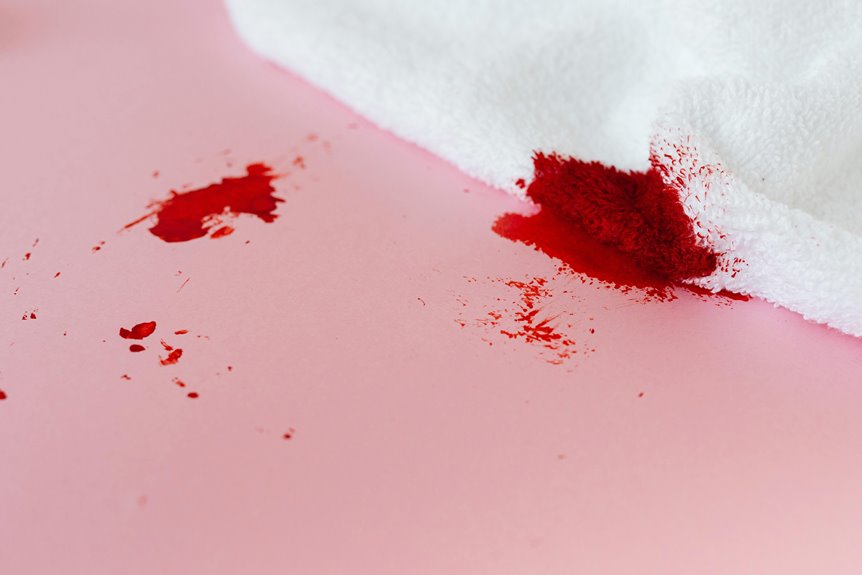To remove any oil stain from fabric, first gently blot excess oil without rubbing to avoid spreading it. Identify the oil type—cooking oils respond well to dish soap and warm water, while motor oils may need stronger cleaners. Apply baking soda or cornstarch to absorb fresh stains, then treat with dish soap and gently scrub. Avoid heat until the stain is gone to prevent setting it. With the right steps and products, you’ll restore your fabric effectively and learn more ways to handle tough stains.
Table of Contents
Key Takeaways
- Identify the oil type (cooking, motor, or cosmetic) to choose the correct cleaning method for effective stain removal.
- Blot excess oil gently without rubbing, check fabric care labels, and place absorbent cloth underneath before treating stains.
- Use household items like baking soda, dish soap, or commercial stain removers such as OxiClean MaxForce for fresh or old stains.
- Avoid heat drying until the stain is fully removed; air dry and repeat cleaning if any stain remains.
- Prevent stains by wearing protective clothing, using stain removers promptly, and applying fabric protector sprays.
Understanding Different Types of Oil Stains
Although all oil stains may seem similar, they come from various sources like cooking oils, motor oils, and cosmetic products, each requiring a different cleaning approach.
When you deal with cooking oil stains, their lighter consistency often means they soak into fabric quickly but respond well to dish soap and warm water.
Motor oil is thicker and more stubborn, so you’ll need stronger degreasers or specialized stain removers.
Cosmetic oils, such as those from lotions or makeup, can contain additives that might affect how the stain sets.
Recognizing the type of oil helps you choose the right treatment and increases your chances of completely removing the stain.
Preparing Fabric for Oil Stain Treatment
Before you start treating an oil stain, you need to prepare the fabric properly to increase the chances of successful removal.
First, gently blot the stain with a clean cloth or paper towel to absorb excess oil—don’t rub, as that can spread the stain or push it deeper.
Next, check the fabric care label to guarantee you use appropriate cleaning methods. If the fabric is washable, turn it inside out and place a clean, absorbent cloth or paper towel underneath the stained area to prevent the oil from seeping through.
Avoid applying any heat, like hot water or a dryer, since heat can set the stain permanently.
Preparing the fabric this way sets the stage for effective stain treatment and helps protect your garment.
Using Household Ingredients to Remove Oil Stains
You can tackle oil stains using common household ingredients like baking soda, dish soap, and vinegar.
Follow simple steps to apply these remedies effectively and watch the stain lift away.
Remember to handle your fabric gently to keep it looking its best throughout the process.
Common Household Stain Removers
When oil stains happen, you don’t need fancy products to tackle them; common household ingredients can work wonders.
Baking soda, for example, absorbs fresh oil stains effectively—just sprinkle it over the spot and let it sit for a while.
Dish soap is another powerful option, designed to cut through grease; apply a small amount directly to the stain and gently rub it in.
White vinegar helps break down oil residues, especially combined with warm water.
Cornstarch works similarly to baking soda by soaking up excess oil from fabric.
Even baby powder can help lift oil when applied promptly.
These items are usually on hand and safe for most fabrics, making them your go-to tools for quick, effective oil stain removal without the need for specialized cleaners.
Step-by-Step Oil Removal
Household ingredients like baking soda, dish soap, and cornstarch provide a simple and effective way to tackle oil stains on fabric.
First, gently blot the stain to remove excess oil without rubbing it deeper. Sprinkle baking soda or cornstarch over the stain and let it sit for 15-30 minutes to absorb the oil.
Next, brush off the powder carefully. Apply a small amount of dish soap directly onto the stain, working it in with your fingers or a soft brush. Let it sit for 5-10 minutes.
Rinse the fabric with warm water and check if the stain has faded. Repeat the process if necessary before washing the garment as usual.
This method uses common household items to break down and lift oil stains effectively.
Tips for Fabric Care
Although oil stains can be stubborn, using common household ingredients carefully can protect your fabric while removing them effectively.
Start by blotting the stain gently to avoid spreading it. Use baking soda or cornstarch to absorb excess oil before treating the area.
When applying dish soap or liquid detergent, choose one with grease-cutting properties and test it on a hidden fabric spot first to prevent discoloration.
Avoid hot water initially, as it can set the stain; instead, use cold or lukewarm water.
After treatment, wash the fabric according to its care label.
Remember, always air-dry the fabric to check if the stain is gone because heat from a dryer can make any remaining oil stain permanent.
Following these tips helps you maintain your fabric’s quality while tackling oil stains efficiently.
Best Commercial Products for Tackling Oil Stains
When oil stains won’t budge with household tricks, it’s time to reach for top oil stain removers designed for tough jobs.
You’ll find effective stain removal sprays that target grease and lift it from fabric quickly.
Let’s explore the best commercial products that make tackling oil stains easier.
Top Oil Stain Removers
If you want to tackle oil stains quickly and effectively, choosing the right commercial stain remover can make all the difference. These products are designed to break down tough grease without damaging your fabric. Here are some top picks that users swear by for their power and reliability:
| Product Name | Why You’ll Love It |
|---|---|
| Zout Laundry Stain Remover | Works fast on fresh and old stains |
| OxiClean MaxForce | Multi-enzyme formula for deep cleaning |
| Shout Advanced Gel | Thick gel clings to stains for better action |
| Goo Gone Kitchen Cleaner | Great for oil stains on non-clothing fabrics |
With these options, you’ll feel confident attacking stubborn oil stains and restoring your fabric’s look. Just apply, wait, and wash!
Effective Stain Removal Sprays
Because oil stains can set quickly, using an effective stain removal spray lets you act fast and target grease directly.
Products like OxiClean MaxForce and Shout Advanced Gel are designed to break down oil molecules on contact, making them ideal for fresh and stubborn stains. Simply spray the affected area, let it sit for a few minutes, then wash as usual.
These sprays often contain enzymes and surfactants that penetrate fabrics without damaging them. For delicate fabrics, you can try products labeled safe for sensitive materials to avoid discoloration.
Remember to always test the spray on a hidden spot first. By keeping a reliable stain remover spray handy, you’ll be prepared to tackle oil spills immediately, increasing your chances of complete stain removal.
Step-by-Step Process for Treating Fresh Oil Stains
Although fresh oil stains can seem intimidating, you can tackle them effectively by acting quickly and following a clear process.
First, gently blot the stain with a clean cloth or paper towel to absorb excess oil—avoid rubbing, as this spreads the stain.
Next, sprinkle baking soda or cornstarch over the stain and let it sit for 10-15 minutes to draw out oil. Afterward, brush off the powder carefully.
Then, apply a small amount of liquid dish soap directly onto the stain and gently work it in with your fingers or a soft brush. Let it sit for 5 minutes before rinsing with warm water.
Finally, launder the fabric as usual but air dry it to check if the stain is fully removed before using the dryer. Repeat if necessary.
Techniques for Removing Set-In or Old Oil Stains
When oil stains have set into fabric over time, they require a more targeted approach than fresh stains.
Start by gently scraping off any residue without damaging the fabric. Apply a degreasing dish soap or a heavy-duty liquid detergent directly onto the stain, and let it sit for 10 to 15 minutes.
Next, use a soft-bristled brush to work the soap into the fibers, breaking down the oil. Rinse with warm water and check the stain.
For persistent marks, apply a paste made from baking soda and water, letting it sit for 30 minutes before gently scrubbing.
Finally, wash the fabric in the hottest water safe for the material. Avoid drying until the stain is gone, as heat can set it permanently.
Tips for Preventing Oil Stains on Fabric
Tackling set-in oil stains can be challenging, so taking steps to prevent them in the first place saves you time and effort.
Always wear an apron or old clothes when cooking or handling oily substances. When eating greasy foods, be mindful and use napkins or plates to minimize contact with your fabric.
Treat your laundry routine carefully—avoid overloading the washer to guarantee proper cleaning and remove oily residues. If you’re working with oil-based products, keep a stain remover pen or wipes handy for quick action.
Also, consider applying a fabric protector spray on your clothes to create a barrier against stains.
Frequently Asked Questions
Can Oil Stains Damage Fabric Fibers Permanently?
Yes, oil stains can permanently damage fabric fibers if you don’t treat them quickly. The oil may weaken or discolor the fibers, making the fabric look worn or stained even after cleaning attempts. Act fast!
Is It Safe to Use Bleach on Oil-Stained Clothes?
You shouldn’t use bleach on oil-stained clothes because it can damage the fabric or set the stain permanently. Instead, pretreat with a stain remover or detergent designed for grease before washing.
How Do Professional Cleaners Remove Oil Stains Effectively?
Professional cleaners use specialized solvents and degreasers to break down oil stains. They pre-treat the fabric, then use hot water and powerful detergents, ensuring the stain lifts without damaging your clothes. You’ll get great results!
Can Oil Stains Be Removed From Delicate Fabrics Like Silk?
Imagine gently wiping a butterfly’s wing—removing oil stains from silk requires the same delicate touch. You can tackle these stains using mild detergent and cold water, but avoid harsh scrubbing to keep your fabric flawless.
What Should I Do if Oil Stain Removal Causes Fabric Discoloration?
If oil stain removal causes discoloration, stop immediately. Rinse with cold water and avoid harsh chemicals. Test treatments on a hidden area next time, and consider consulting a professional cleaner to prevent further damage.
- The Use of Nonwovens in Construction and Civil Engineering - July 11, 2025
- The Use of Nonwovens in Construction and Civil Engineering - July 11, 2025
- The Use of Nonwovens in Construction and Civil Engineering - July 11, 2025







